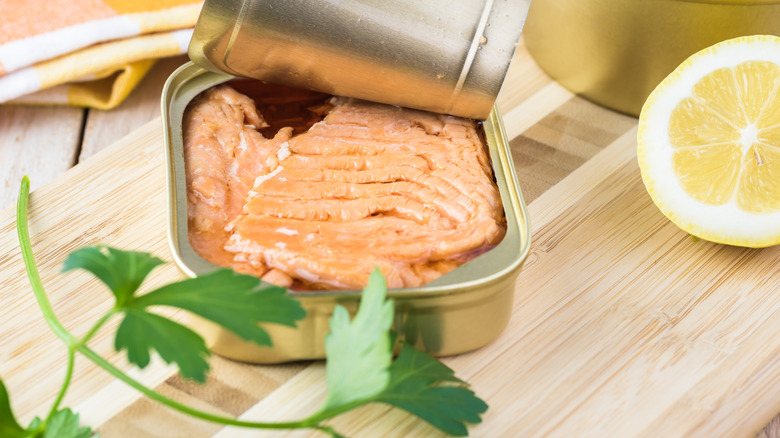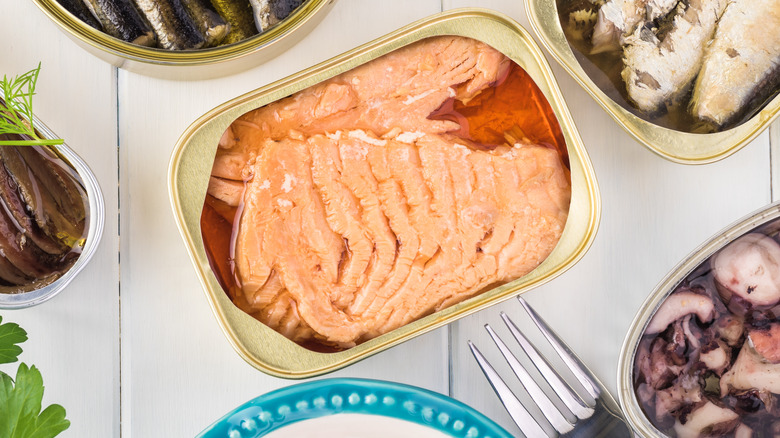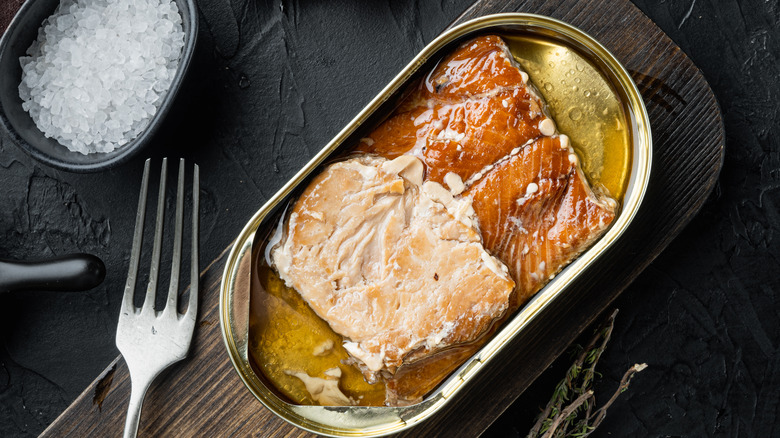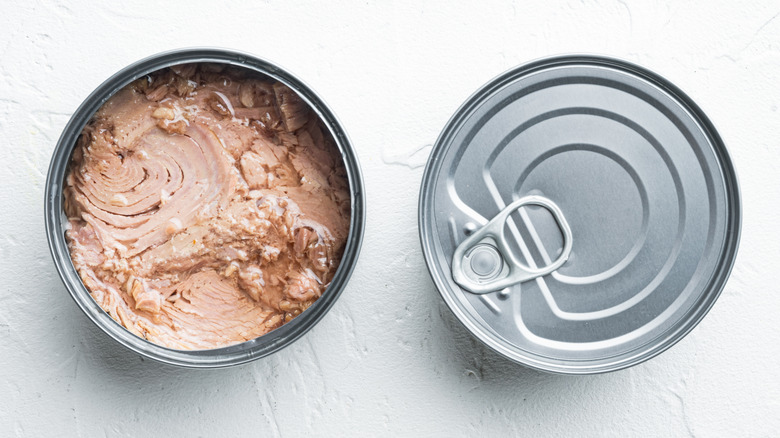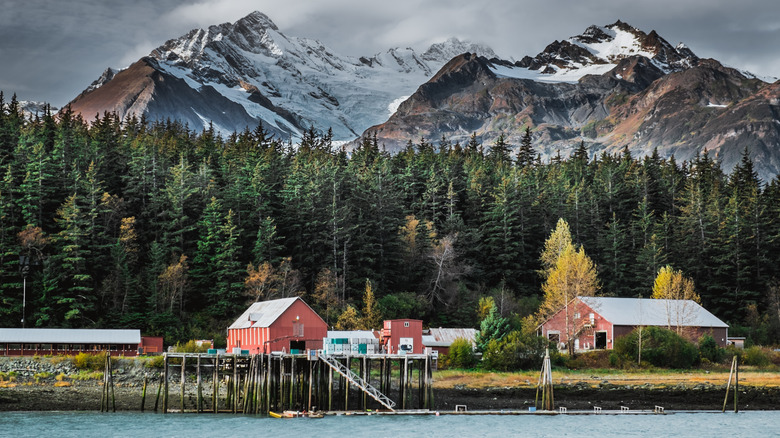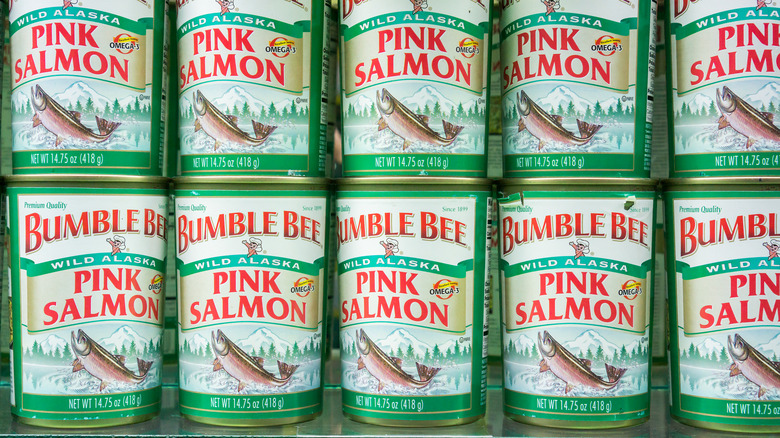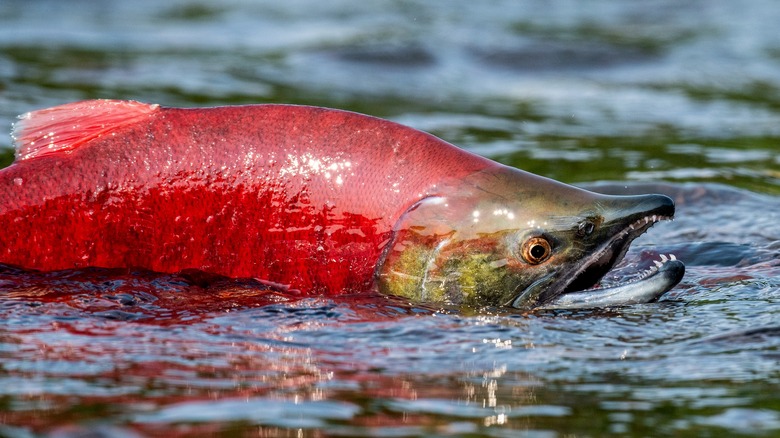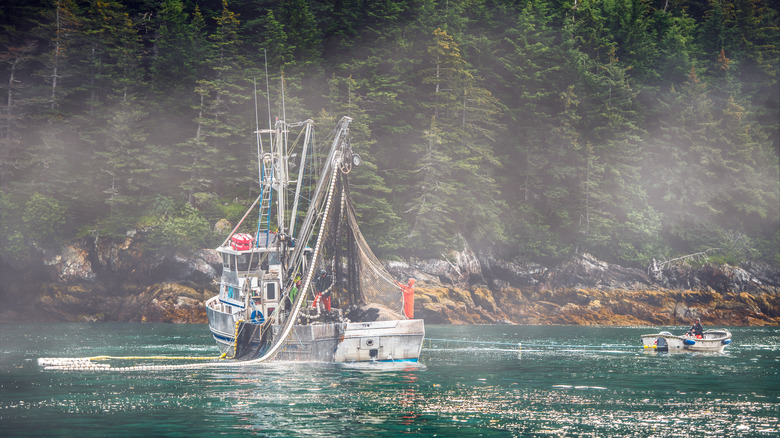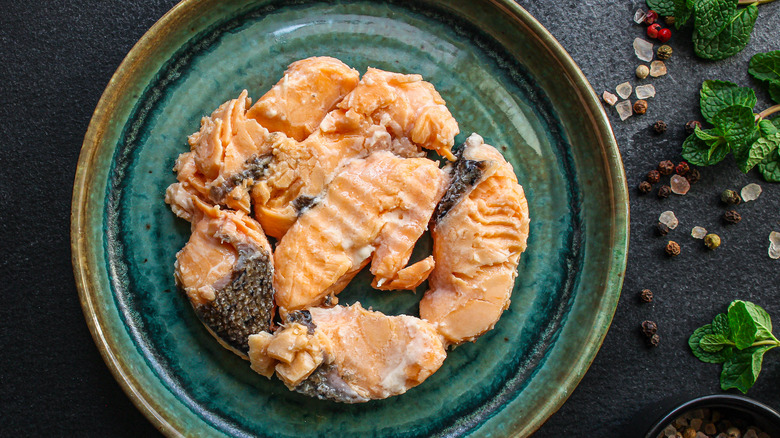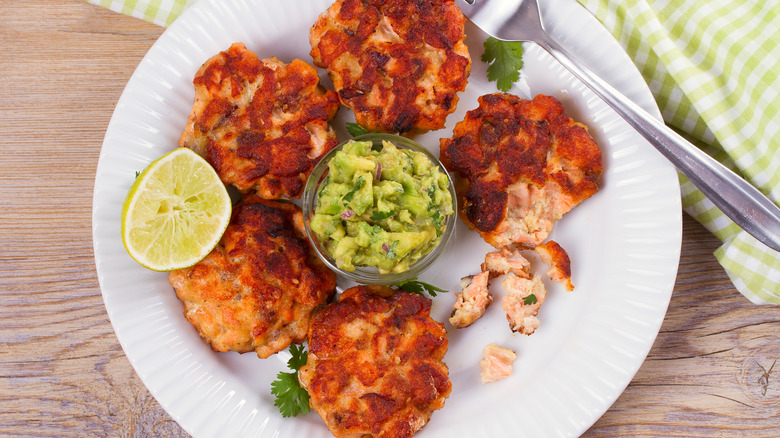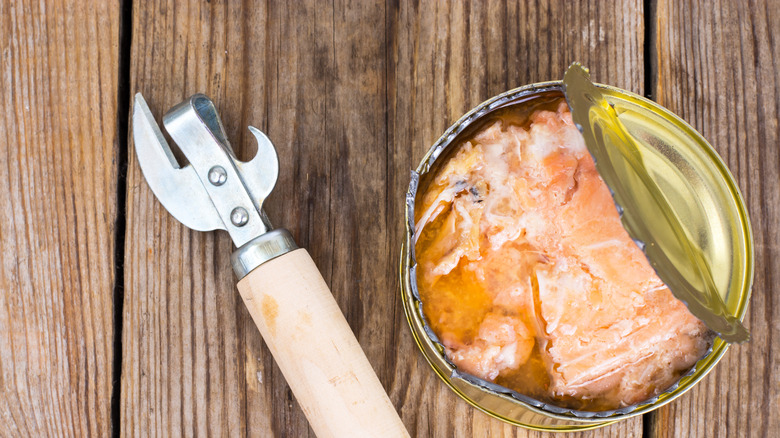The Untold Truth Of Canned Salmon
While canned salmon might not receive the same amount of attention as the more ubiquitous canned tuna, it's an equally affordable, nutritious, and versatile ingredient that you might want to start stocking in your pantry if you're not already. Although, maybe you are — according to Anchorage Daily News, sales of canned Alaskan salmon soared by over 30% in 2020. Granted, that may have been because grocery store shelves were bare of many more popular items, but canned salmon is nothing to sniff at.
It's healthy, easy to use, and a great sustainable seafood option. It also happens to have a longer history and more American roots than tuna, though the latter has probably shown up in far more lunchboxes and casseroles over the past several decades.
Once you start looking at the many brands of canned salmon available, you might be surprised at how similar most of them are in terms of both ingredients and nutrition — though of course there are some outliers. Your choices are most commonly between canned red salmon and canned pink salmon, with or without added salt, and skinless and boneless or not. We'll dive deeper into these important differences and compare and contrast canned salmon with the more common canned tuna. Naturally, we'll explore the best ways to use canned salmon in healthy, easy, and delicious meals too.
So if you haven't yet been inspired to grab a couple of cans of salmon, maybe this will lure you in — and we bet you'll get hooked.
Canned salmon is a healthy choice
Salmon is one of the healthiest fish options out there. It's packed with protein and omega-3 fatty acids, as well as several vitamins and minerals (via Healthline).
The high levels of omega-3 fatty acids make it an especially heart-healthy food, with the American Heart Association recommending at least two servings of fatty fish like salmon per week. While the word "fatty" might scare you off, it shouldn't — omega-3 fatty acids are known to help decrease the risk of stroke and heart disease. Salmon is high in fat, but it's the unsaturated kind. Unsaturated fat, according to the Harvard School of Public Health, can help lower blood cholesterol and inflammation. Harvard Health Publishing puts canned fish "pretty much on a par" with fresh health-wise, and a USDA study found slightly higher levels of omega-3 fatty acids in some canned salmon than in fresh salmon.
Want specific numbers? Per SF Gate, one serving of canned salmon will provide at least 40% of the recommended daily intake of protein, at least 42% of the recommended daily intake of selenium (an antioxidant), and at least 63% of the recommended daily intake of omega-3 fatty acids. It's high in vitamin D, which helps maximize calcium absorption, and is a good source of B vitamins that support skin and nerve health.
Another bonus? Despite being a processed food, canned salmon usually doesn't contain any additives besides salt — and sometimes not even that — nor any artificial preservatives.
You should pay attention to how much sodium is in canned salmon
Most canned salmon contains only salmon and salt. The added salt acts as both a preservative and flavor enhancer, but if you're watching your sodium intake, take a look at the nutrition label.
One serving of most canned salmon brands contains somewhere between 200 and 300 milligrams of sodium, or around 10% of the recommended daily intake. Kirkland Signature canned salmon, Wild Planet's Wild Pink and Sockeye canned salmon, Chicken of the Sea canned salmon, and 365 by Whole Foods canned salmon all range between 200 and 240 milligrams of sodium per serving, while Bumble Bee canned salmon creeps up to 250 milligrams. Starkist canned salmon contains a whopping 320 milligrams of sodium per serving.
One health specialist told Runner's World that he cautions clients to look for low-sodium canned salmon. These options will still contain some natural sodium but no added salt. Crown Prince canned salmon, for instance, clocks in at only 55 milligrams of sodium per serving. Trader Joe's Wild Alaskan Pink Salmon contains 60 milligrams, and Wild Planet's no salt added option has 85 milligrams.
To reduce sodium levels, you can always rinse your canned salmon after draining the liquid; per food scientist Dr. Andrew Clarke, this shouldn't reduce the levels of omega-3 fatty acids in the fish (via Kiowa County Press).
Canned salmon is better for you than tuna in some respects
While the importance of flavor can't be understated, it's also useful to know whether canned salmon is better for you than canned tuna, or vice versa. Nutritionally speaking, they're both pretty healthy, with high amounts of protein that are roughly equivalent, though salmon contains a little more (via Well + Good).
Tuna, whether fresh or canned, is leaner than fresh or canned salmon, but as previously mentioned, the fat in salmon is the good kind — and it contains higher levels of those beneficial omega-3 fatty acids than tuna does. Interestingly, tuna packed in water retains more of its omega-3 fatty acids than tuna packed in oil, according to Livestrong. Canned salmon is rarely packed in oil, but if you have the option, you should go for a brand packed in water to get the most health benefits.
Per Healthline, canned salmon is also the winner when it comes to vitamin D but otherwise it's on fairly equal footing (finning?) with tuna fish.Salt content varies widely from brand to brand, but generally speaking, canned tuna and canned salmon contain comparable amounts of sodium.
There is one other notable factor: mercury. Canned tuna infamously contains high levels of this metal (particularly albacore, also labeled as white tuna), so the Environmental Defense Fund recommends limiting consumption — and suggests canned salmon as a healthier alternative. Canned salmon does contain mercury as well, but at much lower levels (via the FDA).
Canned salmon is older than canned tuna
Per the Alaska Historical Society, the first salmon cannery in Alaska started in 1878. The salmon canning business expanded rapidly; in 1936, 8 million cases of canned salmon came out of Alaska alone (via Alaska Historical Society). That's not to say the booming American industry was cause for unmitigated celebration — overfishing in the absence of strict regulations was a real concern, as were the impacts upon Indigenous people who traditionally relied on salmon stocks (reverberations of which continue to this day, according to the Wild Salmon Center).
Regardless of what was happening behind the scenes, by the early 1900s, canned salmon was popular among American consumers and people across the globe. It was around this same time, writes Slate, that canned tuna was initially introduced. Previously, tuna had not been valued or considered desirable.
While tuna became a huge business in America by the 1950s and '60s, as of 2020, Americans were consuming 40% less tuna per capita than they were in the 1980s. The beginning of the pandemic boosted its profile as people were stocking their pantries with shelf-stable options. It did the same for its predecessor, canned salmon (via Anchorage Daily News).
Canned salmon isn't all the same type of fish
Canned salmon is always salmon, but there's more than one variety of this fish. The six types of salmon found in North America, according to the USGS, are chinook (also known as king salmon), coho, chum, sockeye, pink salmon, and Atlantic salmon.
Each kind of salmon varies in taste, texture, and appearance, ranging from pale pink, comparatively low in fat, and relatively mild to deep orange-red, quite oily, and strong in salmon flavor (via Quora). You can find most of these salmon varieties as fresh or frozen steaks and filets, but canned salmon is almost always labeled either pink salmon or red salmon.
Per NOAA Fisheries, pink salmon is the most common species found in the Pacific Ocean. Canned pink salmon is on the milder side, so it's great for those who find stronger-tasting salmon too fishy. However, it can be a bit mushier too.
Canned red salmon is sockeye salmon, and is often labeled as such. According to the Alaska Department of Fish and Game, sockeye is nicknamed red salmon because of the color the fish turn when they swim upriver to spawn. The flesh of sockeye is more vivid in color than pink salmon. Its taste is stronger and its texture richer and firmer.
You can find canned coho salmon, often smoked, and canned chum salmon too, but they are far less common in grocery stores.
Canned red salmon costs more than pink salmon
Pink salmon is more affordable in part due to its relative abundance, but sockeye salmon are considered the most economically significant salmon harvested in Alaska (via the Alaska Department of Fish and Game). Fewer sockeye salmon are caught overall, so naturally, they cost more. But as their more intense color and richer flavor and texture are highly prized by salmon lovers, that also contributes to the higher price of canned red salmon.
According to Pure Alaska Salmon, blind taste tests have actually shown a slight preference for pink salmon among participants, although when asked, they tend to say they prefer red or sockeye salmon. The company proposes a theory that the bias toward red salmon stems from the early days of salmon fishing, when the more delicate pink salmon didn't hold up as well without modern refrigeration methods.
The richer appearance of the orange-red flesh may also be a factor with blindfolds off, although the canning process actually mutes the colors of both fish so the difference is far less striking than when fresh. Taste-wise, it's not surprising that the mildly-flavored pink salmon might be more broadly appealing.
Depending on what brand of canned salmon you buy and where, prices will vary, but the Wild Planet canned salmon sold directly from the company's website is a good example. The skinless, boneless sockeye salmon costs $7.50 per 6-ounce can, whereas their skinless and boneless pink salmon is only $5.67 per 6-ounce can.
Canned salmon can be a sustainable seafood choice
Another thing canned salmon has going for it is its sustainability, particularly compared with many brands of canned tuna. In either case, it's important to look for wild-caught and sustainably-harvested fish to ensure the least environmental impact.
Most canned salmon is made from wild-caught Alaskan salmon, in which case the label will note that fact. According to The Atlantic, these salmon populations are far easier to keep tabs on than tuna, which means they're not in danger of being overfished, although other factors like climate change do impact their numbers.
Modern methods of fishing for salmon are also more environmentally friendly, and less likely to result in bycatch compared to tuna fishing — although canned tuna that is sustainably harvested in certain waters is almost on par with canned salmon, per the Environmental Defense Fund (EDF). The EDF rates wild Alaskan salmon (including canned) as a best choice, ecologically speaking, and also notes its low mercury content. Farmed salmon that is raised in net pens is labeled a "worst" choice from an environmental perspective.
Even if your salmon was caught in Alaska, that doesn't necessarily mean it was packed in the United States; according to Dr. Weil, many brands process at least some of their catch in factories in Thailand, Vietnam, and China, which of course means greater carbon emissions associated with transportation.
Canned salmon is fully cooked (and often contains skin and bones)
As with canned tuna, canned salmon is fully cooked and ready to eat right out of the tin. Unlike with tuna, canned salmon sometimes contains skin and bones — primarily because the fish are smaller overall and it's more difficult to cut portions of boneless flesh from them (via Quora).
This can actually be a good thing, nutritionally speaking. Canned salmon with bones contains a higher amount of calcium, and the cooking process softens the bones so they're easily crushed with a fork or your fingers when breaking up the meat (via 30 Seconds). Any gelatinous skin can be picked out, but per Healthline it has more omega-3 fatty acids than the meat does.
If the skin and bones gross you out, skinless and boneless canned salmon is widely available. Naturally, it costs a bit more due to the additional processing, but not so much that it's likely to be a deal breaker. Wild Planet's skinless and boneless sockeye salmon, for instance, costs about $0.25 more per ounce than its sockeye with skin and bones.
If you're curious about how canned salmon is made, the Bumble Bee description of their salmon canning process is pretty standard: Heads, fins, tails, scales, and other unwanted parts are removed before the fish are cleaned, cut to size, and added to cans along with salt. Lids are sealed and stamped, and the canned salmon is cooked, cooled, labeled, and packaged for shipping.
Canned salmon is incredibly versatile
Not quite sure how to eat canned salmon? Start by treating it any way you would tuna (after either picking out or mashing in the skin and bones if need be). Try a salmon salad sandwich, with or without mayo. You can serve it on crackers or greens if you're avoiding bread. You can add canned salmon to pasta to bulk it up and boost the flavor. It's also great on top of a simple garden salad, or you can make a salmon Caesar if you're feeling fancy.
Salmon patties are another easy way to transform canned salmon into a meal. Cook them on the stovetop, or try these 15-minute air fryer salmon cakes. Experiment with different spices to change them up.
At breakfast time, try stirring canned salmon into scrambled eggs or quiche to start the day swimmingly. Any time you need to incorporate a low-effort protein into something you're cooking, canned salmon is a great choice.
Canned salmon lasts a long time
Canned salmon's shelf life can easily extend past the use-by date, which is primarily there to indicate how long it will taste its best. Generally, canned salmon will keep at least three to five years unopened and properly stored (via Still Tasty). Ditto for salmon that comes in a vacuum-packed pouch.
Store canned salmon in a cool, dark place with a fairly constant temperature and throw away any cans that develop leaks, bulges, rust spots, or severe dents. If the can looks fine, even if it's several years out of date, go ahead and open it. As long as the salmon still smells good and looks normal (i.e., no mold, obvious changes to the color and texture, or to the viscosity of the liquid), it should still be safe to eat.
Once you've opened canned salmon, store any leftovers in the fridge for no more than a few days. You may have heard that keeping opened cans in the refrigerator can leach metals into your food, and while that is possible, especially for higher-acid foods, the USDA says it's safe to do so for at least a few days. However, your canned salmon will probably taste better and worry you less if you transfer it to a glass or plastic container first. Still Tasty says you can freeze canned salmon in an airtight container for up to three months.
